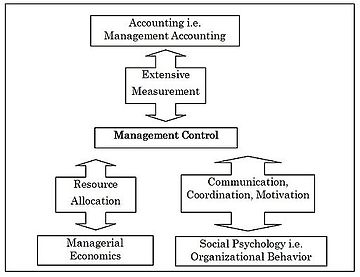Project management is the process of leading the work of a team to achieve all project goals within the given constraints. This information is usually described in project documentation, created at the beginning of the development process. The primary constraints are scope, time, and budget. The secondary challenge is to optimize the allocation of necessary inputs and apply them to meet pre-defined objectives.

In management accounting or managerial accounting, managers use accounting information in decision-making and to assist in the management and performance of their control functions.

An audit is an "independent examination of financial information of any entity, whether profit oriented or not, irrespective of its size or legal form when such an examination is conducted with a view to express an opinion thereon." Auditing also attempts to ensure that the books of accounts are properly maintained by the concern as required by law. Auditors consider the propositions before them, obtain evidence, and evaluate the propositions in their auditing report.
In the field of management, strategic management involves the formulation and implementation of the major goals and initiatives taken by an organization's managers on behalf of stakeholders, based on consideration of resources and an assessment of the internal and external environments in which the organization operates. Strategic management provides overall direction to an enterprise and involves specifying the organization's objectives, developing policies and plans to achieve those objectives, and then allocating resources to implement the plans. Academics and practicing managers have developed numerous models and frameworks to assist in strategic decision-making in the context of complex environments and competitive dynamics. Strategic management is not static in nature; the models can include a feedback loop to monitor execution and to inform the next round of planning.
A marketing plan may be part of an overall business plan. Solid marketing strategy is the foundation of a well-written marketing plan so that goals may be achieved. While a marketing plan contains a list of actions, without a sound strategic foundation, it is of little use to a business.
Marketing management is the organizational discipline which focuses on the practical application of marketing orientation, techniques and methods inside enterprises and organizations and on the management of a firm's marketing resources and activities.
Management by objectives (MBO), also known as management by planning (MBP), was first popularized by Peter Drucker in his 1954 book The Practice of Management. Management by objectives is the process of defining specific objectives within an organization that management can convey to organization members, then deciding how to achieve each objective in sequence. This process allows managers to take work that needs to be done one step at a time to allow for a calm, yet productive work environment. In this system of management, individual goals are synchronized with the goals of the organization.

Business performance management (BPM), also known as corporate performance management (CPM) enterprise performance management (EPM), organizational performance management, or simply performance management are a set of management and analytic processes that ensure activities and outputs meet an organization's goals in an effective and efficient manner. Business performance management is contained within approaches to business process management.
A balanced scorecard is a strategy performance management tool – a well structured report, that can be used by managers to keep track of the execution of activities by the staff within their control and to monitor the consequences arising from these actions.
Information technology (IT)governance is a subset discipline of corporate governance, focused on information technology (IT) and its performance and risk management. The interest in IT governance is due to the ongoing need within organizations to focus value creation efforts on an organization's strategic objectives and to better manage the performance of those responsible for creating this value in the best interest of all stakeholders. It has evolved from The Principles of Scientific Management, Total Quality Management and ISO 9001 Quality management system.

Activity-based costing (ABC) is a costing method that identifies activities in an organization and assigns the cost of each activity to all products and services according to the actual consumption by each. Therefore, this model assigns more indirect costs (overhead) into direct costs compared to conventional costing.

A performance indicator or key performance indicator (KPI) is a type of performance measurement. KPIs evaluate the success of an organization or of a particular activity in which it engages. KPIs provide a focus for strategic and operational improvement, create an analytical basis for decision making and help focus attention on what matters most.
IT portfolio management is the application of systematic management to the investments, projects and activities of enterprise Information Technology (IT) departments. Examples of IT portfolios would be planned initiatives, projects, and ongoing IT services. The promise of IT portfolio management is the quantification of previously informal IT efforts, enabling measurement and objective evaluation of investment scenarios.
The following outline is provided as an overview of and topical guide to business management:
Control is a function of management which helps to check errors in order to take corrective actions. This is done to minimize deviation from standards and ensure that the stated goals of the organization are achieved in a desired manner.
IT Application Portfolio Management (APM) is a practice that has emerged in mid to large-size information technology (IT) organizations since the mid-1990s. Application Portfolio Management attempts to use the lessons of financial portfolio management to justify and measure the financial benefits of each application in comparison to the costs of the application's maintenance and operations.

A shared services center – a center for shared services in an organization – is the entity responsible for the execution and the handling of specific operational tasks, such as accounting, human resources, payroll, IT, legal, compliance, purchasing, security. The shared services center is often a spin-off of the corporate services to separate all operational types of tasks from the corporate headquarters, which has to focus on a leadership and corporate governance type of role. As shared services centers are often cost centers, they are quite cost-sensitive also in terms of their headcount, labour costs and location selection criteria.
Business–IT alignment is a process in which a business organization uses information technology (IT) to achieve business objectives, such as improved financial performance or marketplace competitiveness. Some definitions focus more on outcomes that means ; for example,
Alignment is the capacity to demonstrate a positive relationship between information technologies and the accepted financial measures of performance.
A glossary of terms relating to project management and consulting.
Management accounting in supply chains is part of the supply chain management concept. This necessitates planning, monitoring, management and information about logistics and manufacturing processes throughout the value chain. The goal of management accounting in supply chains is optimizing these processes. This strategy focuses on supporting management.




